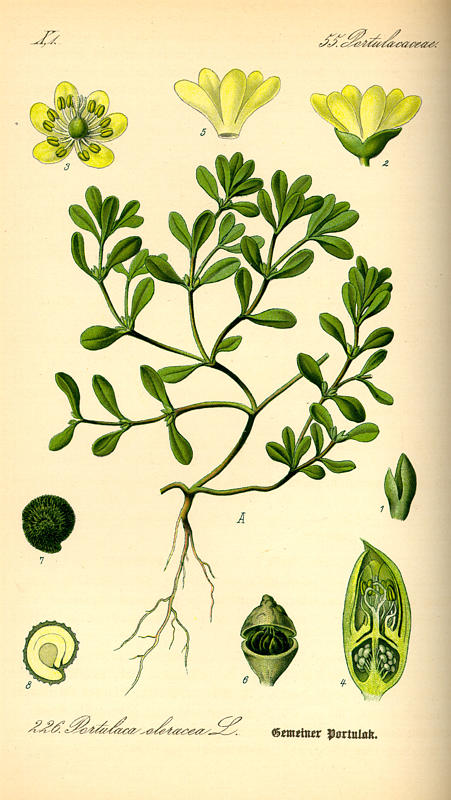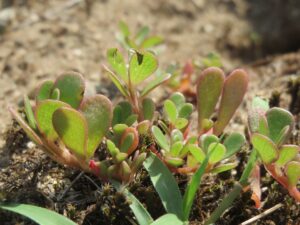Herb: Portulaca oleracae
Common Names: Purslane, red root, purlsey, little hogweed, Duckweed, Flatweed, Moss Rose Family Portulacaceae
Ayurvedic Name: / Ma Chi Xian TCM
Parts Used: Stems, leaves, seeds, juice, flower buds
Native Region: Europe, Asia
Geographic Distribution: Worldwide in damp areas
Botanical Description: Purslane is a small annual succulent, staying around six inches in height, it likes to creep. It has small thick, rounded leaves and small yellow flowers growing in clusters – although it can have other colors of the flower when it’s cultivated.

Figure 1 Original book source: Prof. Dr. Otto Wilhelm Thomé Flora von Deutschland, Österreich und der Schweiz 1885, Gera, Germany
Harvesting Guidelines: Gather throughout the growing season, and all aerial parts are edible.
Constituents: Oxalic acid, omega-3 fatty acids, Vitamins A, C, E, B, magnesium, calcium, potassium, iron, pectin, dopamine, fructose, glucose, alkaloids, coumarins, flavonoids, cardiac glycosides.

Figure 2 Image by WikimediaImages from Pixabay
Uses: Constipation, coughs, dermatitis, dysentery, fever, food, headaches, inflammation, insect bites and stings, itchy skin, ulcer, worms (the seeds according to de baircle), wounds and the properties are similar to Aloe and can be used effectively for burns.
Purslane has been used for at least 2,000 years in Europe, Iran, and India. In ancient Rome, it was used to treat headaches, stomachaches, and dysentery as well as intestinal worms.
Gerard said “Raw purslane is much valued in salads with oil, salt and vinegar. It cools hot stomachs and provokes appetite. “The juice of purslane stoppeth the bloody fluxe, the fluxe of the hemorroides, monthly termes, spitting of blood and all other fluxes whatsoever (Gerard, 1633/2015). (Exact quote including old English spelling.)
Culpeper believed nothing was better than purslane for curing hot agues, choleric fluxes of the belly and women’s courses. He also believed it was good for sore mouths and gums, and to fasten loose teeth, and relieved gout.
Native Americans used purslane as a poultice for burns, and juice for earaches (Foster/Duke, 2014)
Purslane may have beneficial effects on the serum lipids of adolescent and obese children and is well tolerated, although further long-term studies on the prevention of adolescent cholesterol disorders are warranted. In a triple-blind, randomized, placebo-controlled study, participants who took the purslane capsules showed a drop in their total cholesterol over those who took a placebo. (Sabzghabaee, 2014).
Bruised and applied to the forehead and temple to reduce excessive heat, and the eyes to remove inflammation Grieve, 1992).
A Greek dish called Horta with purslane, dandelion greens, nettles, and other wild greens can be used medicinally to help with liver disorders and digestion issues (Gladstar, 2012)
A study on the benefits of Purslane on postoperative peritoneal adhesions in rats suggests that oral infusions improved – or rather – lowered the incidence of adhesions, as well as lowered inflammatory responses. Further clinical studies are required on humans to be conclusive (Jaafari, 2021).
Actions: Refrigerant, anti-inflammatory, cardiac protective, diuretic, analgesic, antidiabetic, demulcent, antioxidant
Dosage & Safety: 1 handful or more, in salad 1-2x daily. 1 teaspoon of seeds daily to cure worms (de Bairacli Levy, 1997) Do not take purslane in medicinal quantities while pregnant. Avoid eating large amounts of raw purslane if you have a tendency toward kidney stones.
Preparations: Poultices, teas, foods, tinctures, powders, washes, capsules, juices
Taste: Sour, salty. Energy: Cooling, moistening.
Notes / References:
Apelian, Nicole and Davis, Claude. Lost Book of Herbal Remedies. AskAPrepper.com
De Bairacli Levy, Juliette. Common Herbs for Natural Health. First published 1974, reprinted 1997. Ashtree Publishing.Woodstock, NY
Culpeper, Nicholas and Foster, Steven. Culpeper’s Complete Herbal. First printed 1652, edited by Foster in 2019. Sterling Publishing, New York, NY
Gerard, John. The Herbal, or General History of Plants. 1633 edition revised, enlarged, Johnson Thomas. Calla Editions, Mineola, NY
Gladstar, Rosemary. Medicinal Herbs: a Beginner’s Guide. 2012 (P. 124 recipe). Storey Publishing. North Adams, MA
Grieve, Mrs. M. A Modern Herbal. First published in 1931, edited and reprinted 1992. Dorset Press, New York
Foster, Steven and Duke, James A. Peterson Field Guide to Medicinal Plants & Herbs of Eastern & Central North America. 2014. Houghton Mifflin. New York, NY
De la Foret, Rosalee and Han, Emily. Wild Remedies. 2020. Hay House Publishing, Carlsbad, CA
Sabzghabaee AM, Kelishadi R, Jelokhanian H, Asgary S, Ghannadi A, Badri S. Clinical Effects of Portulaca Oleracea Seeds on Dyslipidemia in Obese Adolescents: a Triple-blinded Randomized Controlled Trial. Med Arch. 2014;68(3):195- 199. doi:10.5455/medarh.2014.68.195-199
Jaafari A, Baradaran Rahimi V, Vahdati-Mashhadian N, et al. Evaluation of the Therapeutic Effects of the Hydroethanolic Extract of Portulaca oleracea on Surgical-Induced Peritoneal Adhesion. Mediators Inflamm. 2021;2021:8437753. Published 2021 Jul 31. doi:10.1155/2021/8437753

Kathy is an herbalist/naturopathic practitioner who is constantly researching to expand her knowledge. She came to herbalism after her migraine medicine was suddenly removed from the market and she had to find something new. After discovering the magic of herbs she’s never looked back. She is accredited by the International Practitioners of Holistic Medicine (IPHM) and is an Associate Member of the American Herbalist Guild.